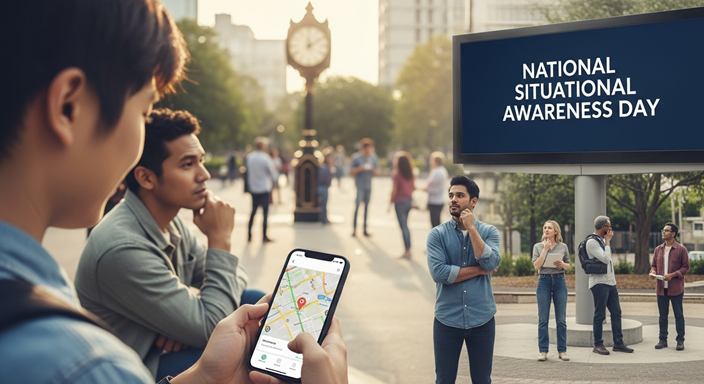In today’s fast-paced #world, #awareness is not just a skill but a necessity. Every day, we are surrounded by countless distractions—our #phones, #gadgets, #work pressures, and #social commitments. These distractions can make us less attentive to our #surroundings, increasing the risk of #accidents, #miscommunication, and even threats to personal #safety. This is where National Situational Awareness Day plays a crucial role. It reminds us to #pause, #look around, and stay #mindful of what’s happening in the present moment. The message of the day can be summed up in a simple phrase: awareness saves lives.
The observance highlights the importance of being alert, cautious, and responsible in public, private, and professional spaces. By improving our attention to detail, we can avoid dangers, support others in need, and make better decisions in daily life. #NationalSituationalAwarenessDay
History of National Situational Awareness Day
National Situational Awareness Day was first introduced in 2015 by Pretty Loaded, a safety awareness training company founded by Beth Warford. The idea came from the growing concern about personal safety and the rise of preventable crimes, accidents, and emergencies due to lack of awareness.
Pretty Loaded’s vision was to encourage citizens to develop proactive habits of situational awareness, not only for personal safety but also for the safety of families, communities, and workplaces. Since then, the day has gained recognition across the United States and has gradually inspired global conversations about safety practices.
The foundation of the day lies in the belief that “prevention is better than cure.” By empowering people with knowledge, self-defense strategies, and alertness, many dangerous incidents can be avoided altogether.
Importance of Situational Awareness Day
The importance of National Situational Awareness Day is deeply rooted in safety and responsibility. Here are the key reasons why the day matters:
-
Prevents accidents and mishaps – Staying alert reduces risks in public spaces, workplaces, and roads.
-
Empowers individuals – Awareness gives people the confidence to take charge of their safety.
-
Encourages vigilance against crime – Recognizing unusual or suspicious activity early can prevent crimes.
-
Boosts emergency response – Quick recognition of danger leads to faster, life-saving actions.
-
Promotes mindfulness in daily life – The practice of awareness not only ensures safety but also sharpens focus, clarity, and productivity.
In short, the day stresses the value of being proactive instead of reactive.
Significance of National Situational Awareness Day
The significance of this day extends far beyond personal safety. It serves as a cultural reminder to adopt vigilance in every area of life.
-
For individuals: It enhances decision-making, protects from scams, and ensures safety while traveling, shopping, or commuting.
-
For families: It instills responsible habits in children and prepares households for emergencies.
-
For workplaces: It promotes a culture of security, alertness, and compliance with safety protocols.
-
For communities: It builds a sense of mutual responsibility, where people look out for one another.
At its core, the day represents the balance between freedom and safety—reminding us that freedom without vigilance is fragile.
Why Situational Awareness Day is Celebrated
National Situational Awareness Day is celebrated to:
-
Raise awareness about personal safety practices.
-
Educate people about the dangers of complacency.
-
Reduce preventable crimes and accidents.
-
Spread the culture of vigilance in public and private spaces.
-
Honor those who promote safety training and awareness in society.
By dedicating a day to this cause, organizers hope to spark conversations, spread information, and inspire collective action toward making communities safer.
How Situational Awareness Day is Celebrated?
Celebrations for National Situational Awareness Day are practical and awareness-driven rather than festive. Some of the common ways include:
-
Workshops and Seminars – Organizations and safety groups conduct sessions to train people in situational awareness.
-
Self-defense training – Martial arts schools and training institutes hold special events to empower individuals, especially women.
-
Social media campaigns – Hashtags like #NationalSituationalAwarenessDay trend, spreading practical tips on vigilance.
-
Community events – Local safety officers, police departments, and NGOs organize demonstrations to show how awareness prevents incidents.
-
Corporate programs – Offices arrange short training for employees on cyber safety, workplace hazards, and personal security.
-
Educational initiatives – Schools introduce children to safety games and roleplays that build alertness.
Where Situational Awareness Day the Day Celebrated?
National Situational Awareness Day began in the United States, but its relevance is global. Countries like Canada, the UK, Australia, and India have gradually embraced the idea in various forms, often linking it with public safety awareness weeks or campaigns.
In the digital age, the celebration has also found space on global platforms. Through online training sessions and awareness drives, people across continents now observe and participate in spreading the message.
How Citizens Involve Themselves and Make It a Success
The success of National Situational Awareness Day depends largely on how citizens participate. Some of the most impactful ways include:
-
Practicing awareness in daily life: Staying alert in public transport, at shopping malls, or while driving.
-
Educating peers and family: Sharing safety tips with loved ones, especially children and elderly family members.
-
Supporting campaigns: Volunteering for community events, attending workshops, and spreading awareness online.
-
Using social media effectively: Posting reminders, sharing stories, and inspiring others to stay vigilant.
-
Learning new skills: Enrolling in self-defense classes or first-aid training.
Citizens who adopt these practices not only safeguard themselves but also strengthen the fabric of their communities.
Theme for Situational Awareness Day 2025
The proposed theme for National Situational Awareness Day 2025 is:
“Stay Alert, Stay Safe: Awareness is Your Superpower.”
This theme emphasizes that awareness is not just a defensive skill but a powerful strength that everyone can cultivate.
10 Famous Quotes for Situational Awareness Day
-
“Awareness is the greatest agent for change.” – Eckhart Tolle
-
“The price of safety is eternal vigilance.” – Unknown
-
“Awareness is the key to safety, and safety is the key to freedom.” – Beth Warford
-
“Distraction is the enemy of awareness.” – Anonymous
-
“When you know better, you do better.” – Maya Angelou
-
“Preparedness is not paranoia; it is responsibility.” – Pretty Loaded
-
“The first step to safety is awareness.” – Unknown
-
“Awareness turns chaos into clarity.” – Anonymous
-
“Safety is something that happens between your ears, not just on the road.” – Unknown
-
“Your best defense is your awareness.” – Self-defense principle
FAQs about National Situational Awareness Day
Q1. When is National Situational Awareness Day celebrated?
A1. It is observed annually on September 26.
Q2. Who started National Situational Awareness Day?
A2. The day was founded in 2015 by Pretty Loaded, under the leadership of Beth Warford.
Q3. What is the main purpose of Situational Awareness Day?
A3. To promote safety, vigilance, and alertness in daily life.
Q4. Is the day celebrated worldwide?
A4. While it originated in the United States, many countries now observe or promote similar awareness campaigns.
Q5. How can I participate in the celebration?
A5. By staying alert, sharing safety tips, attending workshops, and spreading the message online.
Q6. Why is situational awareness so important?
A6. It helps prevent accidents, crimes, and emergencies by enabling proactive decisions.
Q7. Does the day focus only on physical safety?
A7. No, it also includes cyber safety, workplace vigilance, and emotional awareness.
Q8. Who benefits the most from situational awareness training?
A8. Everyone, but especially children, women, elderly citizens, and people working in high-risk environments.
Q9. Is there a theme every year?
A9. Yes, different themes highlight specific aspects of awareness and safety.
Q10. Can organizations take part in the observance?
A10. Absolutely. Many corporates, NGOs, schools, and community groups host events to promote awareness.
Conclusion
National Situational Awareness Day is more than just an observance—it is a movement toward building safer, stronger, and more mindful communities. Founded in 2015 by Pretty Loaded, the day has steadily expanded its influence, reminding us every September 26 to be vigilant and responsible.
The celebration may not involve fireworks or parades, but its impact is long-lasting. It saves lives, prevents dangers, and creates a culture of mindfulness. As the 2025 theme rightly says, “Stay Alert, Stay Safe: Awareness is Your Superpower.”
By practicing situational awareness daily, each one of us contributes to a safer society. The day is a call to action: don’t just live, but live aware.
|
!!! Stay Updated !!! 👉 Follow and Join us on 👈 📰 Trending News | 📢 Important Alerts | 💼 Latest Jobs LinkedIn | Threads | Facebook |Instagram | Tumblr 📱 Follow us daily & never miss an update 📱 |

Someshwar Chowdhury is a seasoned Chartered Mechanical Engineer, Educator, and Technology enthusiast with over a decade of experience in engineering education and consultancy. Someshwar is also an active blogger, trainer, and member of professional bodies like ISHRAE and GREEN ADD+. When not teaching or consulting, he enjoys blogging, music, and exploring green technologies.
Discover more from Today's Significance
Subscribe to get the latest posts sent to your email.
